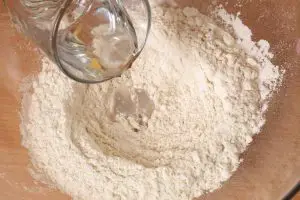People say that ‘carbs are life’ and when you think of carbs, it’s impossible not to think of bread.
Bread makes all of life’s pains feel better. Bread doesn’t judge us, bread won’t shout at us, bread won’t betray us, it will simply continue to taste delicious, light, soft, fluffy, and heavenly, especially served warm with real butter.
The great thing about bread is the fact that it’s so simple to make, and so versatile at the same time. From focaccia and sourdough to bruschetta and baguettes, there are so many different types of bread out there that it would be impossible to list them all. What’s especially exciting about bread is the fact that the different ingredients used in the dough will yield such different and diverse results.
We know you can use oils in breads, along with various herbs and spices, but what about the liquids? Does the liquid we use when making a bread dough really affect the bread, and if so, which is best. Lately more and more people have been experimenting with milk in their bread dough, but is it any good, or is this just a fad? Let’s find out.
Here’s a look at what happens to your bread dough if you add milk to it instead of water.
Last update on 2024-07-13 / Affiliate links / Images from Amazon Product Advertising API
What does milk do to bread dough?
Thinking about baking a loaf of bread this weekend? If so, then hold your horses because you might want to consider making just one change and substituting milk instead of water when mixing up your dough.
Milk may indeed be great when poured over cereal, but it turns out that it’s also a very beneficial ingredient when used for making bread as well.
To understand why milk is so beneficial for baking bread, we first need to look at exactly what’s inside it? Milk is primarily made up of water (close to 90% in fact) which means that it’s a great alternative to water when used in a bread dough.
Milk also contains a sugar which is known as lactose, and it’s here where things get scientific. During the fermentation process, the yeast is unable to break down the lactose sugars. This means that these sugars aren’t used by the yeast. Does this mean that the bread is sweeter? Hmm, well, perhaps a touch, depending on whom you ask, but the main benefit is that the lactose sugars caramelize as the bread bakes.
That isn’t all however, because milk’s fat content also makes a difference. The fat in milk gives the dough a softer, lighter crumb structure by bonding gluten protein strands more securely and also shortening them too. The crumb of the bread is therefore shorter, but also much tougher and stronger too.
Just because the bread is tougher however, don’t assume this will make it dry or dense, because in reality the higher fat content results in more water being retained, so the bread is actually softer, and also lasts longer too.
How to use milk when baking bread?
Just because you can use milk to make a bread dough, this does not mean that you can just throw it into the mix like you would with water.
To begin with, you should use slightly more milk than you would water, due to the fact that milk is around 87% water. Generally, then, aim for around 10% more milk than water. If for example, your recipe called for 100ml of water, you would add 110ml of milk. This will help ensure the dough isn’t too dry.
You should also bake the bread at a slightly lower temperature than you would if you were using water. This is because of the lactose sugars in the bread and the fact that, as they are present throughout the bake, they begin to caramelize in the oven. If you have the temp too high, this can cause the bread to burn on the outside and remain raw and doughy in the middle.
Finally, you need to scald the milk first. No, this doesn’t mean you give it a stern telling off, but rather, you heat the milk to just below boiling.
Scalding the milk gives the bread a light, soft, and airy texture as it breaks down glutathione which softens the gluten and makes the bread weaker. Heating the milk destroys the glutathione which helps keep the gluten intact. This gives a firmer, lighter, airier texture to the bread, and helps it rise.
How to scald milk?
Scalding milk is very simple. To start with, you heat the milk to 82 degrees C (180F) for just a second, and then you take it off the heat.
The milk is now just below boiling, so light bubbles will form and steam will appear. Make sure you take the milk off the heat as soon as it reaches 180F, as anything more will give the milk a bitter taste.
Set the milk aside to cool slightly to below 120F, as anything more than this will damage the yeast and/or kill it entirely if the temp exceeds 140 F.









